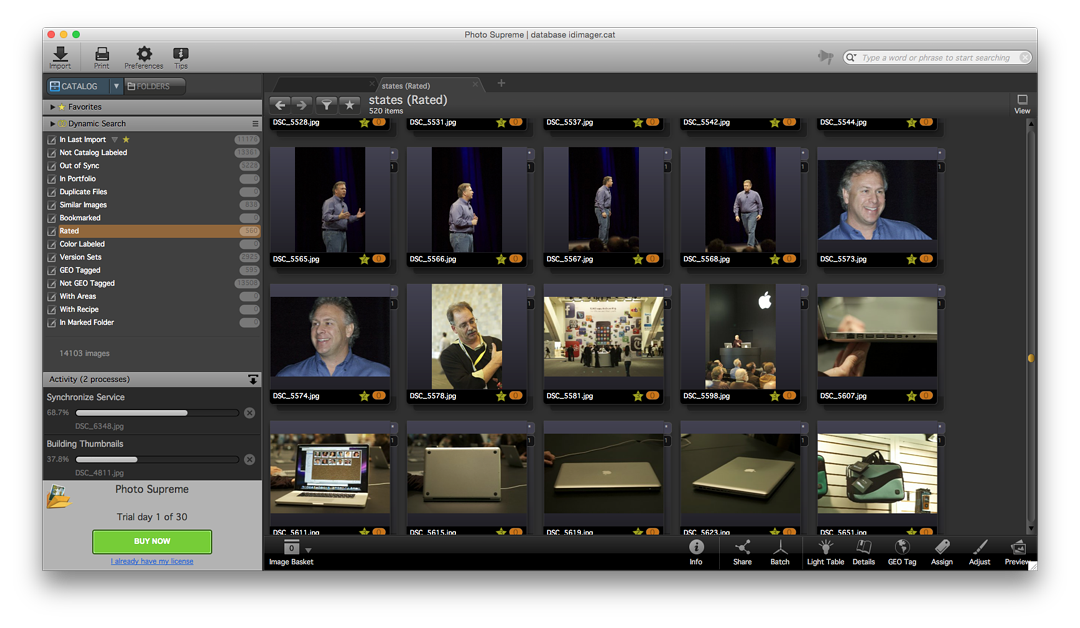Seeking Replacements for Aperture (Part 5): ID Imager Photo Supreme - A Good Candidate

AMITIAE - Friday 15 May 2015
|
Seeking Replacements for Aperture (Part 5): ID Imager Photo Supreme - A Good Candidate |
 |
|
|
By Graham K. Rogers
After I wrote the first three articles on my examination of possible Aperture replacements, two other applications were pointed out to me: Perfect Browse and ID Imager Photo Supreme. I looked first at Perfect Browse, but decided to download the test version of the full Perfect Photo Suite as this had editing tools as well. Although it had a number of likable features, this is not my replacement for Aperture. Likewise, as suggested by another reader, ACDSee was rejected in my earliest examination of possible candidates and did not even make my first shortlist. I do not like the way it handles images, particularly when (on being installed) it changed the "Open With" Finder settings for all of them. Right or wrong, my impression when I first installed this a while back was that it had too many leftovers from Windows and I wanted none of that. A user needs to be happy with the software being used.
Photo Supreme was downloaded as a package and with Apple's sandboxing, needs the user to confirm - and confirm again - that installation is really wanted. As near as I could, I followed the same procedure as I had with Perfect Browse (and Perfect Photo).
Photo Supreme - ImportingAt startup, there were two immediate differences: an offer to download a user manual; and a Wizard to access images. To my delight, all of my Aperture libraries were visible on one of the disks I have these backed-up on. Once I had highlighted one of the libraries, I started the import process. With the library size this took a long time.There were a number of delays during the process of working on the over 14,000 images. Early on, one of these delays was due to what was indicated as "Versioning", while other delays came from the lengthy process of Synchronising Service and the building of thumbnails. A catalog system was built inside the users Library folder: a series of instructions and databases. The images themselves would remain on the external disk. As the images were brought in, so the display to the left of the screen showed attributes, including those that were Geo-tagged. Clicking on one or two of these displayed thumbnails, but at this early stage some were unavailable. During the import, I examined some related items, including the Data menu which showed a number of import options. Not only was Aperture shown, but iPhoto, Lightroom, MediaPro, iMatch, FotoTime, as well as certain text import options (e.g., Keywords). It took around 3 hours for all in that first library to be imported and catalogued. The catalog itself was some 1.8 GB, but there were no images at all on the Mac's hard disk. They were all still on the external disk, which was exactly what I wanted.

The software recognized that a card had been connected and correctly identified the camera. I was invited to copy the images to a new folder. The Photos folder on the main hard disk was offered by default, but I was able to change that. I was also offered an option to catalog the files (or not). More settings gave me a number of import options, including making the RAW image the main (something Photos does not yet work properly with). I was able to select the RAW images manually and then press Import. Although there seems to be a certain roughness here, particularly compared to the smooth workflow that Aperture provides, Photo Supreme does manage the digital assets quite effectively. Learning how to organise projects is not so easy (at least on this brief acquaintance), although it is becoming a little clearer.

The larger library has slightly fewer images, but most of these came from the later Nikon D7000 camera and each photograph is larger. Aperture reports some 3,000 images for that second library. The inflated figure probably includes originals, edited versions and thumbnails. I am currently using the Date option in the Catalog search, which allows me to open each year, each month and then access separate days. I can also use this catalog system by rating, color label, file type. Also available are catalog state, version placeholder, image details (each giving separate sets of parameters); and of course, All.
Photo Supreme - Editing and ExportingInfo and Details controls on the bottom of the screen (towards the right side), gave me access to metadata, while a useful Geo-tagging feature allowed me to append data manually or via a small Google Map display, centred on New York. I initially tried to drag this to focus on Bangkok, but a "Lookup" button allowed me to enter a search paramater and the map obliged by switching to the Land of Smiles. Dragging the map about was painfully slow and kept centering on my current location: better to use coordinatesWith images available for examination, I clicked on the Adjust button at the bottom of the screen. This revealed a fair number of editing tools, with colors, exposure and related controls. These were grouped into Canvas (Crop, Rotate, etc.); Filters, for adjusting the image; and Presets, with options for user-created presets (like in Aperture effects).

Exporting an image was via a Share tool and this had to be setup carefully in terms of image size and format. Exporting an image to the desktop required the addition of a new folder icon for each size. When a new one was added, a panel appeared for the user to set the export parameters. On this early run, I found this awkward. There were a selection of standard sharing options, like Facebook and Mail, with the ability to add more. I still have much to learn here (as I do with the organisation of projects when importing).
CommentsPhotos is not a replacement for a Pro application and by suggesting that Aperture users can shift to Adobe Lightroom, Apple is turning its back on a significant group of users, many of whom have remained faithfull for years. But Apple does that sometimes.Apparently so did ID Imager a couple of years ago when it shifted to its Photo Supreme. Comments on a blog by Geoff Coupe - and his update (at the bottom) - may be useful to put the application in some perspective. Of the five applications I have examined in the last week or so, only this last one - Photo Supreme from ID Imager - matches most of my requirements: access to existing Aperture libraries; ability to import directly from a camera or digital source (e.g. SD card); reasonable in-app editing tools; and image export options. There are also several useful cataloging and search functions, which would allow a user considerable flexibility in the organisation of images. Right now the photographs have just been brought in en masse and need to be tidied up. Photo Supreme falls down a little on the matter of image export with a somewhat idiosyncratic system of sharing. The editing tools too would require a period of learning although the basic sliders and other controls are recognisable in the main. For now, I am keeping Aperture running and have installed it on my new Mac mini for the time being. It will work at least until the end of Yosemite's life and perhaps even into the next version of OS X. Of course, I would like it to continue and cannot help but feel a little bitterness towards Apple and its alienating decision. Of the five applications I looked at, I have deleted Corel After Shot (Test version) and the Nikon Capture NX-D. I have retained Darktable for the time being. I will delete the test version of Photo Supreme for now. I rejected the Corel and Nikon software for a number of reasons, while Photo Supreme is just not needed right now. If nothing else comes along between now and when Aperture is no longer usable, I will gladly lay down my $99.99 and move to that.
See also
Graham K. Rogers teaches at the Faculty of Engineering, Mahidol University in Thailand where he is also Assistant Dean. He wrote in the Bangkok Post, Database supplement on IT subjects. For the last seven years of Database he wrote a column on Apple and Macs. He is now continuing that in the Bangkok Post supplement, Life. |
|

For further information, e-mail to
Back to
eXtensions
Back to
Home Page